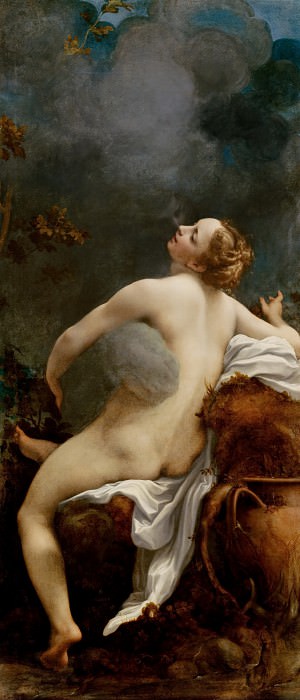Correggio – Jupiter and Io Kunsthistorisches Museum
Kunsthistorisches Museum – Correggio -- Jupiter and Io
Edit attribution
Download full size: 3000×7024 px (6,7 Mb)
Back to album: Kunsthistorisches Museum
"Jupiter and Io" is a painting by the Italian Renaissance painter Antonio Allegri known as Correggio. It is in the Vienna Museum of the Arts. The painting was conceived after the success of Correggio’s previous work, Venus, Satyr and Cupid. The painter is known to have painted four canvases in all, although more may have been planned. In the first edition of his book, Renaissance biographer Giorgio Vasari mentions only two paintings: Leda and the Swan (now in Berlin’s Gemaldegalerie) and one Venus (quite possibly referring to Danae, now in Rome’s Borghese Gallery), although he knew them only from descriptions provided by Giulio Romano. Vasari mentions that Duke Federico Gonzaga wanted to donate the works to Emperor and King Charles V of Spain: that two other works, Ganymede taken by the Eagle and Jupiter and Io, were in Spain during the 16th century, and were part of the same series.
Description of Correggio’s Jupiter and Io
"Jupiter and Io" is a painting by the Italian Renaissance painter Antonio Allegri known as Correggio. It is in the Vienna Museum of the Arts. The painting was conceived after the success of Correggio’s previous work, Venus, Satyr and Cupid. The painter is known to have painted four canvases in all, although more may have been planned.
In the first edition of his book, Renaissance biographer Giorgio Vasari mentions only two paintings: Leda and the Swan (now in Berlin’s Gemaldegalerie) and one Venus (quite possibly referring to Danae, now in Rome’s Borghese Gallery), although he knew them only from descriptions provided by Giulio Romano.
Vasari mentions that Duke Federico Gonzaga wanted to donate the works to Emperor and King Charles V of Spain: that two other works, Ganymede taken by the Eagle and Jupiter and Io, were in Spain during the 16th century, and were part of the same series. The canvas has been in Vienna since the early 17th century, when it is mentioned in the imperial collections of the Habsburgs along with "Ganymede."
The scene of Jupiter and Io is inspired by the classic works of Ovid. Io, daughter of Inacus, the first king of Argos, is seduced by Jupiter (or Zeus), who hides behind the dunes to avoid being seen by the jealous Juno (in Greek mythology, Hera).
Jupiter often seduced other women and adopted various disguises to conceal his adventures. He appeared to his lovers as a swan or an eagle, but in this picture he remained himself. Jupiter embraces the nymph Io, his face barely visible. She pulls Jupiter’s misty, smoky hand toward her with barely restrained sensuality. The contrast between the disappearing figure of Jupiter and the substance of Io’s body, shown bewildered, in a kind of erotic rapture, is striking. This motif anticipated many works by Bernini and Rubens.
Кому понравилось
Пожалуйста, подождите
На эту операцию может потребоваться несколько секунд.
Информация появится в новом окне,
если открытие новых окон не запрещено в настройках вашего браузера.
You need to login
Для работы с коллекциями – пожалуйста, войдите в аккаунт (open in new window).




















You cannot comment Why?
The lighting is theatrical; it highlights the contours of the figure and creates stark contrasts between light and shadow. The upper portion of the composition is dominated by dark, turbulent clouds tinged with hints of blue and gold, suggesting an atmosphere charged with emotion or supernatural occurrence. Below this, a cluster of leaves and branches frames the scene, adding depth and complexity to the background.
A large, bronze-colored vessel sits near the womans legs, its function unclear but potentially symbolic. It could represent containment, transformation, or perhaps even a reference to mythological narratives involving metamorphosis. The dark ground upon which she rests contributes to the overall sense of mystery and isolation.
Subtleties within the painting suggest themes of divine intervention and vulnerability. The woman’s upward gaze implies a connection with something beyond her immediate surroundings – perhaps a deity or fate itself. Her exposed state, combined with the turbulent sky, evokes a feeling of exposure and powerlessness in the face of forces larger than herself. The vessels presence introduces an element of ambiguity; it could be interpreted as both a source of protection and a symbol of confinement. Overall, the work conveys a sense of narrative tension and emotional complexity, inviting contemplation on themes of transformation, divine influence, and human fragility.